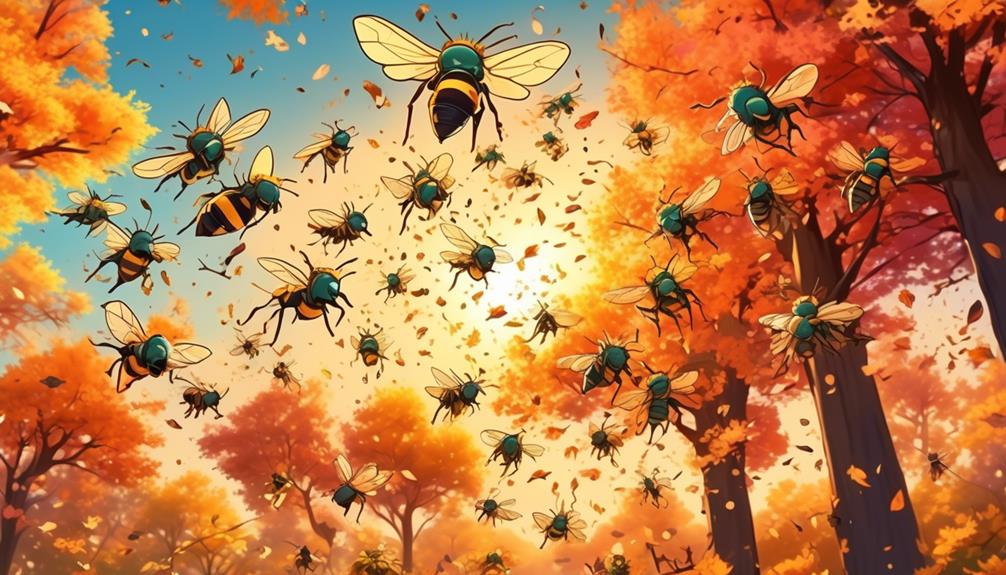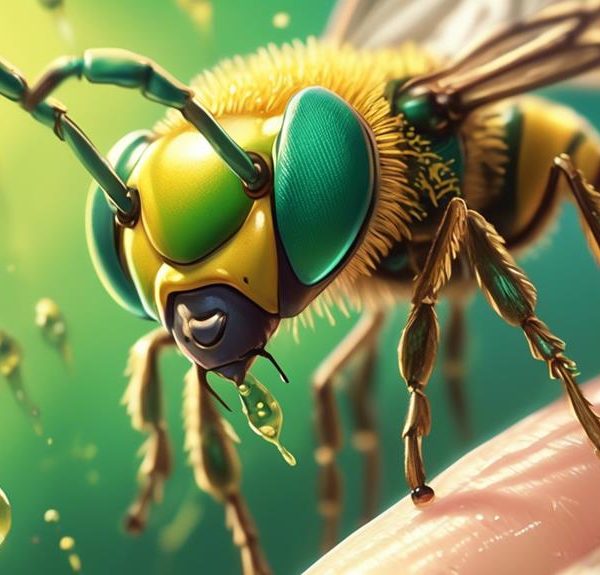Curious about sweat bees and their migration patterns? Dive into the captivating world of these tiny creatures and their unique behaviors.

Do Sweat Bees Migrate
You might think that every bee in the world packs up its pollen and heads south for the winter, but what about sweat bees?
You're sitting there, contemplating these tiny creatures, wondering if they, like their larger honeybee cousins, migrate when seasons change.
You've been observing these fascinating insects, attracted by your perspiration on hot summer days, and now, as seasons are shifting, you're left pondering their fate.
Well, it's not as simple as you may think, and it's about time we demystified this captivating topic.
Hold onto that curiosity, because we're about to plunge into the intriguing world of sweat bees and their behavioral patterns.
Key Takeaways
- Sweat bees have unique social structures, ranging from solitary to eusocial.
- They adapt to diverse environments and can nest in the ground or wood cavities.
- Sweat bees exhibit seasonal changes in behavior, adapting to temperature, food supply, and daylight.
- Factors such as temperature, food availability, and human activities influence sweat bee movements.
Understanding Sweat Bee Behavior

To fully appreciate the migratory patterns of sweat bees, it's crucial to first understand their unique behaviors and social structures. Sweat bees, belonging to the family Halictidae, aren't your average honey-producing bees. They're smaller, often metallic in color, and have a unique social structure that ranges from solitary to eusocial.
In solitary species, individual females construct and provision their nests single-handedly. On the other hand, eusocial species have a more complex social structure, where labor is divided among different types of bees, namely queens and workers. The former lay eggs while the latter are responsible for gathering food and maintaining the nest. You might find it fascinating that some species exhibit both solitary and eusocial behavior, depending on environmental and seasonal conditions.
Their foraging behavior is also noteworthy. Sweat bees are polylectic, meaning they gather pollen from a variety of plants. This trait, combined with their small size, makes them excellent pollinators. They're attracted to human sweat, hence their name, but don't worry, their sting is less painful than that of common bees.
Understanding these characteristics provides a solid foundation for exploring their migratory patterns.
Habitats of Sweat Bees

Diving into their habitats, you'll find sweat bees thriving in a wide array of environments, from meadows and deserts to urban gardens and forests. It's remarkable how these tiny insects adapt to such diverse conditions. They don't limit themselves to rural or wild areas, but can also make a home in urban environments, where they nest in the ground or in wood cavities.
Several factors influence their habitat selection. First, they need a place with loose soil or wood for nesting. Second, the availability of flowering plants is crucial as they provide the nectar and pollen sweat bees feed on.
Sweat bees are solitary creatures, unlike other bees that form large colonies. Each female digs her own burrow, lays eggs, and gathers food. Some species prefer sandy soils, others clay. They're also found in diverse climates – while some species are adapted to arid deserts, others can tolerate cold, mountainous regions.
In essence, sweat bees aren't too picky about where they live, as long as their basic needs are met. They're resilient and adaptable, making them a fascinating study in the realm of insect behavior and habitats.
Seasonal Changes and Sweat Bees

As the seasons shift, so do the behaviors and activities of sweat bees, remarkably adapting to changes in temperature, food supply, and daylight. These small, often metallic-colored bees are highly sensitive to their environment and have evolved to thrive in a variety of seasonal conditions.
In the spring and summer, when flowers are plentiful, sweat bees are active pollinators. They're lured by the abundance of nectar and pollen, using this period to gather food and reproduce. As autumn approaches, their activity decreases in response to the waning food supply and shorter daylight hours.
The colder winter months mark a period of dormancy for the sweat bees. You'll notice their absence, as they hibernate underground, waiting for the warmth of spring to emerge and start the cycle again.
Season | Sweat Bee's Activity |
|---|---|
Spring and Summer | Active pollinators |
Autumn | Decreased activity |
Winter | Dormancy |
Understanding these seasonal changes provides insights into the migratory behavior of sweat bees. Despite their size, these insects play a crucial role in maintaining our ecosystems. So next time you spot a sweat bee, remember the intricate dance it performs with the seasons.
Factors Influencing Sweat Bee Movements

Building on the knowledge of seasonal changes in sweat bee behavior, let's explore the various factors that influence their movements. These factors include temperature variations, food availability, and human activities.
Temperature is a significant factor affecting sweat bee movements. Cold temperatures can cause sweat bees to enter a state of dormancy, while warm temperatures stimulate activity. You'll often find these bees more active during the warmer parts of the day.
Food availability greatly impacts their movement patterns as well. When flowers, which provide the bees with essential nectar and pollen, are scarce, you'll notice sweat bees traveling farther in search of food.
Not to forget, human activities play an increasing role in influencing sweat bee movements. Urban development, which often destroys their natural habitats, forces sweat bees to relocate. Pesticide usage also negatively affects their populations, reducing their numbers and limiting their movements.
Do Sweat Bees Really Migrate?

Examining the idea of migration in sweat bees, it's important to understand that unlike some species of birds and butterflies, these tiny insects don't typically undertake long-distance travel. They're local creatures, and their movements are generally limited to a range within a few kilometers from their nests.
However, you may have heard reports of sweat bees appearing in places where they weren't previously found. The reason for this isn't migration in the traditional sense. Instead, it's likely due to human activities, such as the transportation of goods, that inadvertently move these bees.
Here's a simple comparison between sweat bees and migratory species:
Species | Migration Pattern |
|---|---|
Sweat Bees | Local movements, mostly within a few kilometers of their nests |
Monarch Butterflies | Migrate thousands of kilometers to overwintering sites |
Arctic Terns | Longest migrations, up to 25,000 kilometers |
Conclusion
So, do sweat bees migrate?
The answer isn't as straightforward as you might think. While they don't migrate in the conventional sense, they do move around depending on seasons and resources. Changes in temperature, food availability, and habitat conditions can all influence their movements.
So, while they mightn't travel vast distances as some species do, these industrious insects are certainly not sedentary.
Keep observing the fascinating world of sweat bees – there's always more to discover!



